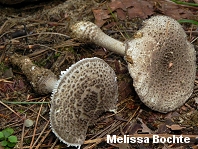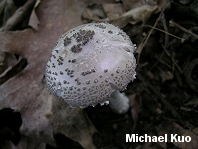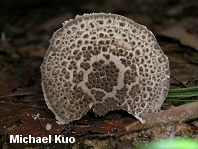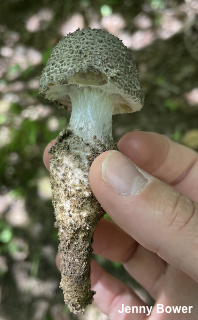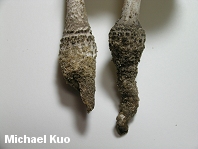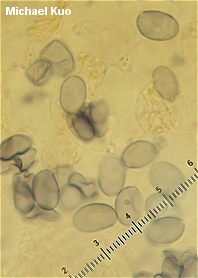| Major Groups > Gilled Mushrooms > Pale-Spored > Amanita > Amanita onusta |

|
Amanita onusta [ Basidiomycota > Agaricales > Amanitaceae > Amanita . . . ] by Michael Kuo This funky gray stinker is one of the few species in section Lepidella of the genus Amanita that is not white or whitish—although it does share many of the other Lepidella hallmarks: a shaggy, "appendiculate" cap margin; a rooting stem base; an odd odor; and amyloid spores. Add to these features the small to medium size of Amanita onusta and its gray-on-gray cap (its pale gray cap surface is covered with darker gray warts and patches), and one has a fairly easy identification. That said, however, there is some fairly substantial variability in the morphological features and ecology of Amanita onusta, and it would not surprise me to find out that there are actually several phylogenetic species hanging out in the current concept of the species. Thanks to Jenny Bower for documenting, collecting, and preserving Amanita onusta for study; her collection is deposited in The Herbarium of Michael Kuo. Description: Ecology: Mycorrhizal with hardwoods or conifers in diverse ecosystems (my southern Appalachian collections have been made under eastern hemlock; my Midwestern collections have been made under oaks); usually growing alone or scattered; summer through fall; originally described from "deeply shaded grassland" in Yonkers, New York; widely distributed from northeastern North America to the Midwest and Jalisco. The illustrated and described collections are from Illinois, Kentucky, and Vermont. Cap: 3.5–6 cm; convex, expanding to planoconvex or flat; dry or, when fresh, slightly sticky; bald and pale gray underneath soft, powdery, easily removed, dark gray warts (or less clearly defined patches, especially away from the center of the cap); the margin often adorned with veil fragments, not lined. Gills: Free from the stem or slightly attached to it; close or nearly distant; white; with frequent short-gills; soft; becoming yellowish and flabby in old age. Stem: 3.5–10 cm long above ground; 0.5–1 cm thick; more or less equal above small basal bulb that features a rooting portion up to 5 cm long; finely shaggy or nearly bald above, but shaggy below; whitish above and grayish below; with a very delicate ring that usually disappears quickly; base often featuring bent-back scales, and more or less concentric zones of gray universal veil material. Flesh: Whitish to pale gray; not staining on exposure. Odor: Strong and foul—like a mixture of rotting meat and chlorine. Chemical Reactions: KOH negative on cap surface. Spore Print: White. Microscopic Features: Spores 8–11 x 4.5–7 µm; ellipsoid; smooth; amyloid. Basidia to about 40 x 8 µm; 2- and 4-spored; clamped. Cystidia not found. Pileipellis an ixocutis or cutis of elements 2–8 µm wide. Lamellar trama bilateral; subhymenium ramose, or with slightly inflated cells. REFERENCES: (E. C. Howe, 1874) P. A. Saccardo, 1891. (Weber & Smith, 1985; Jenkins, 1986; Phillips, 1991/2005; Metzler & Metzler, 1992; Miller & Miller, 2006; Binion et al., 2008; McKnight et al., 2021; Tulloss, cont. upd.) Herb. Kuo 08180604, 06071002, 08111205, 07242106. This site contains no information about the edibility or toxicity of mushrooms. |
© MushroomExpert.Com |
|
Cite this page as: Kuo, M. (2022, July). Amanita onusta. Retrieved from the MushroomExpert.Com Web site: http://www.mushroomexpert.com/amanita_onusta.html |
